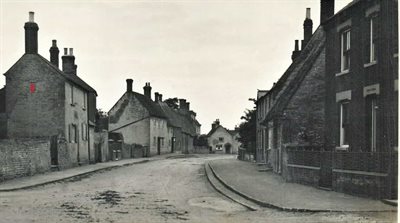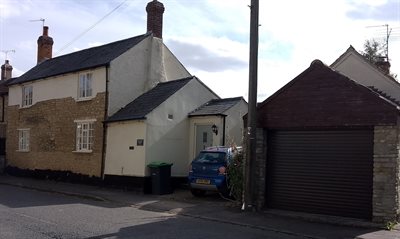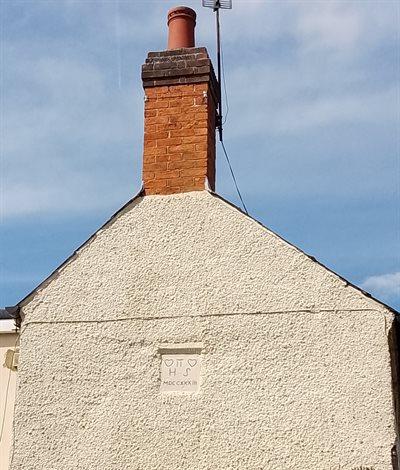The Old Carlton Forge - 18 Bridgend
This page was contributed by Pamela Hider

Carlton Forge from a postcard dated 1920 [ref: Z1306/25/1/2]
The Historic Environment Record for Bedfordshire describes 18 Bridgend as follows:
Pebbledash in stone. 2 storey, slate roof. 2 casements with glazing bars, 3 light to ground floor. Recessed doorway. 18th or 19th century building in Carlton & Chellington Conservation Area, deemed of local interest. It may have been the dwelling for the earlier forge alongside it. The main building has at least two phases visible in the stonework, with two outbuildings to the side and rear likely associated with metal working. A date stone on the southern gable end reads MDCCXXXIII (1733) suggesting that at least the core of the building predates any 19th or 20th century alterations. It may be the forge referred to in 18th century records.
Early History
The work of the village blacksmith was essential at a time when agriculture was the living of rural settlements and horses were not only widely used on farms but were also the main means of transport. The trade ran in families, being passed down from fathers to sons over centuries and every village had its own blacksmith.
Peter Covington (1679 to 1744) was the Turvey blacksmith, a trade going back in his family over at least 3 further generations to late Elizabethan times; whilst in Harrold, it was the Crouch family of blacksmiths who could trace their trade back to 1740. Both of these names also figure in the list of Carlton blacksmiths.
Carlton's earliest record of a blacksmith is to be found in the diary [ref: X185/1] of Benjamin Rogers, Rector of Carlton, for February 25th 1737, when he writes "Paid John Fairy for shooing the Riding Horses 8 li. 10s.,and also for shoeing the Cart Horses 3 li.12s. from October last was 12 Months". Mr.Fairy himself is referred to in his will [ref: ABP/W1771/48] as John Fairy of Carlton, blacksmith. This will also refers to the "blacksmiths adjoining house in the occupation of Robert Boddington, blacksmith", who died in 1768.
19th Century
Census records from 1841 and 1851 show William Covington, blacksmith, aged 59, living with his wife Mary, aged 60, at Bridgend, Carlton. He also appears in Kelly's trade directories of 1847 and 1854 as Carlton blacksmith. It does not follow though that the blacksmith was living at the adjoining house eg. Kelly's directories of 1869 and 1876 list Christopher Crouch as Carlton blacksmith, but censuses of 1851,1861 & 1871 show him to be living with his family in Harrold.
By 1871, his son George Crouch, aged 28, was listed in the census along with his wife Christiana and five children, as living at 'Blacksmith House' in Bridgend. The 1881 and 1891 census also referred to 'Blacksmith House' BUT the actual address was stated in the 1881 census as 6, Bridgend, Chellington. [A Charles Franklin was living at no.18]. George was named as Carlton blacksmith in Kelly's Directories of 1885, 1890, 1894, 1898 and 1901. He died in 1901.
20th Century
In the 1891 census, the occupation of George's son, aged 21, another Christopher, had also been given as blacksmith, and when his father died in 1901, he took over the position of Carlton blacksmith, being listed in Kelly's directory as such in 1910. The censuses of 1901 and 1911 gave his occupation as blacksmith and his address revealed he was still living at 6, Bridgend, Chellington, because he had married Sarah Rudd, whose father owned the property, which had consisted of two dwellings; he and his young family were effectively living alongside their in-laws!
With the approach of war, changes were afoot and Kelly's directory of 1914 now referred to him as a jobbing gardener and running the Post Office in Bridgend. There was now a new Carlton blacksmith - Charles Samuel Gibbs. There is a tradition that* "subpostmaster Mr. Christopher Crouch would see to the morning mail and then go over to Harrold to help his brother who had the ‘smithy’ on The Green".
* "Charles Gibbs took over the forge from the Crouches, but is only remembered being there a short while, before Mr. George Saunders became village blacksmith, staying in the village until about 1937, when he moved to the forge at Odell. As well as smithying, Mr. Saunders also had bikes to sell, displaying them in the big front window of the forge". The window is no longer there but the tall brick chimney of the forge still survives.
In 1927, property in Carlton was valued under the Rating and Valuation Act 1925 [ref: DV1/C218]. Every piece of land and building in the country had to be valued to determine the rates to be paid upon it. The property was described as "Forge & Smithy with stove room facing main toad and used as cycle workshop show room. Brick & Tile smithy 27 x 14 and brick & tile stove 17 x 10 V.G.Buildings V.good Smithy". The occupier was listed as TW Saunders and the owner as J Partridge.
The adjoining house was described as "Rough cast & slate, detached, living room, reception room, upstairs 2 bedrooms, barn, washhouse, Recently done up, Right on Road". The owner and occupier was listed as AJ Partridge. [electoral rolls show the Partridge family to be living there until the 1970s).
End of an era
When the last blacksmith of Harrold died in 1941, the Bedfordshire Times referred to a "rural culture which had largely been destroyed by the encroachment of mechanization". The same fate befell all village blacksmiths of course and remaining properties were converted into private residences. Carlton Forge took the name Hillside Forge in 1938.

Hillside Forge, 2024

Datestone MDCCXXXIII (1733)
* From an unpublished memoir of Carlton and Chellington Historical Society.
Further reading - The Life of a smithy is portrayed in Harrold Community Histories entry for The Old Smithy 49 High St. Harrold.